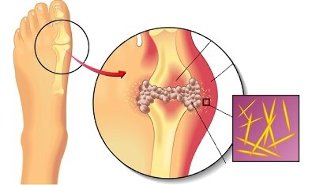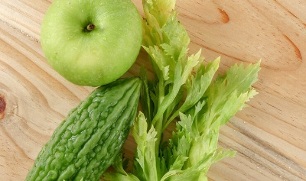
Gout is a disease associated with damage to the exchange of purine bases. It leads to the deposition of uric acid salts in the joints and internal organs.
The main symptom is a recurrent attack of acute arthritis, the formation of tofus (compression foci) on the legs and earlobes. Therapy for the active period is medication using anti-inflammatory drugs.
In order to accelerate the onset of remission and increase its duration, we recommend that the patient adhere to certain principles of nutritional therapy. A diet properly chosen for gout can significantly improve a patient’s quality of life, reduce the number of attacks of the disease, and reduce the risk of irreversible damage to the kidneys, central nervous system, and musculoskeletal system.
Dietary Adjustment Goals and Principles
The main goal of the diet of patients with gout is to reduce the concentration of uric acid complexes in the blood plasma. The products consumed by the patient should be chosen so that none of them contains more than 150 mg of purine per 100 g of weight. The patient is shown in Table 6.
Diet is most effective when the following principles are followed:
- Strict adherence to the rules until irreversible changes occur. With gastronomic constraints, it is impossible to remove already formed conglomerates in the joints and kidneys. The selected menu has a preventive purpose, it helps to prevent salt deposition.
- A dietary approach, taking into account the frequency of crises, uric acid levels, the severity of the process. In addition to aggravation, the diet should contain reduced amounts of protein, fat, sodium salt. Alcohol should be completely eliminated. There are strict restrictions during the active period: the food is gentle, mostly liquid.
- Weight correction. For obese people, the products are chosen so that the total caloric content is 300-500 kcal per day lower than the level of energy consumption. The patient's lifestyle and level of daily physical activity should be considered.
- Not more than 200 mg of purine base per day. The figure shown is critical for the patient. The large amount of uric acid compounds does not allow the body to maintain levels within acceptable limits.
In addition to the above, adherence to the drinking system is required. If there are no contraindications from the cardiovascular system, the patient should consume approximately 2 to 2. 5 liters of fluid per day. Hydrocarbonate mineral waters are recommended. This helps to alkalize the internal environment, reduces acidity.
Nutrition in exacerbations
Dietary restrictions are the most significant in the increased uric acid content of the blood and in the stage of recurrence of the pathology. The total daily amount of proteins should be 70 g, fats - 80 g, carbohydrates - 240 g. The caloric content of the diet is 1950–2000 kcal. Diet - drink four times a day, including fluids. Food temperature is normal, 55-60 ° C for hot food and 15 ° C for cold food. No targeted heat savings are required. It is better if the consistency of the food is liquid or pasty.
The following foods are recommended:

- milk; lactic acid drinks;
- vegetable juice;
- citrus-based juices;
- liquid cereals;
- grated fruits;
- fish eggs;
- tomato sauce.
In the presence of clinical manifestations of the disease, a person should not consume foods that are acceptable during the remission phase. Solid foods, cakes, meat and fish in any form, eggs, sweets, spices, oils should be denied. The requirements for animal proteins are met only by milk materials. Restrictions must be adhered to throughout the attack. On average, this takes 5-7 days. Once the inflammatory process in the legs subsides, they gradually return to a normal diet. The crossing takes 2-3 days.
Nutrition in remission
Adherence to a gouty diet is necessary even in the absence of severe symptoms. The restrictions in this case are not as severe as during exacerbations. However, these must be strictly adhered to. A basic requirement is the complete removal of the maximum purine meat of young animals. Their concentration can reach 1000 mg / 100 g, which is many times the permissible values. Meat extracts, mackerel, sardines, cattle guts (liver, kidneys, brain), alcoholic beverages are also categorically contraindicated.
Table 6 shows the daily consumption of 100 g of protein and fat, 450 g of carbohydrates. The total nutritional value of the daily menu is 3200 kcal. The volume of the liquid is 1, 5–2 liters, if this does not contradict the treatment of other diseases.
The list of actions that a patient can perform includes:
- kefir;
- fresh cabbage cabbage soup;
- buckwheat porridge;
- omelette;
- rye bread;
- fruit jam; vegetable oil;
- lemon or orange;
- mashed potatoes;
- fish souffle;
- cereals;
- eggs;
- cheese;
- dietary meat in quantities not exceeding 120 g / day.
Purine base levels are lowest in foods such as cereals, vegetables, honey, nuts and tomatoes. They can be consumed virtually without restriction. Lard, beans, spinach, sorrel, mushrooms contain 50 to 150 mg of material, which should be taken into account when preparing the menu.
To lose weight
Weight loss is recommended for patients with hypersthenic and normosthenic body shape. The caloric content of the diet should be reduced to 30 calories per kilogram. It is important to lose weight gradually, not more than one kilogram per month. This ensures an acceptable level of ketone body formation. With the express lack of nutritional value of the products, their synthesis exceeds the permitted limits. A low-calorie diet eliminates or significantly limits the consumption of baked goods.
Prohibited foods: bread, pies, pizza, cakes, cheesecakes, pastries, sugar, candies, sweet jam, canned food, etc.
The table should be based on the following components:
- low-fat cottage cheese;
- kefir;
- vegetables;
- fruit.
Weight control is not limited to low calorie meals. The patient should lead an active lifestyle, physical education according to an individually designed program. Otherwise, dietary restrictions will be too strict, which will reduce one's adherence to therapy.
Sample menu for a week
Gout patients know exactly what not to eat and what to eat. It is better to clearly describe your diet for a relatively long time. Meals are usually developed for a week. The existing system can be used for several months, after which the set of dishes is completely changed or mixed every day. With increased uric acid levels, this is how the weekly diet can look.
Monday
- 1st breakfast: casserole, coffee with milk.
- Breakfast 2: baked apples.
- Lunch: vegetable soup, bread, rosehip soup.
- Afternoon snack: fruit jelly.
- Dinner: cabbage rolls, kefir.
Tuesday
- Breakfast 1: cheese, tea, bread.
- Breakfast 2: orange.
- Lunch: lean cabbage soup, bread, herbs.
- Afternoon snack: buckwheat porridge.
- Dinner: kefir, carrot puree.
Wednesday
- Breakfast 1: eggs, juice.
- 2nd breakfast: jam, mineral water.
- Lunch: vegetable peppercorns, rye bread, tea.
- Afternoon snack: milk jelly.
- Dinner: dried fruits, jam.
Thursday
- Breakfast 1: cucumber salad, rosehips.
- Breakfast 2: orange pomace.
- Lunch: potato soup, fruit drink.
- Afternoon snack: pear.
- Dinner: scrambled eggs, dried apricots, lemon tea.
Friday
- Breakfast 1: boiled beets, blueberry juice.
- Breakfast 2: kefir.
- Lunch: pearl barley soup, tea.
- Afternoon snack: milk, bread.
- Dinner: carrot slices.
Saturday
- Breakfast 1: rice, coffee.
- Breakfast 2: watermelon.
- Lunch: soup, milk jelly.
- Afternoon snack: fresh cucumbers.
- Dinner: kefir, bread.
Sunday

- Breakfast 1: soft-boiled eggs with sour cream and tea.
- Breakfast 2: grapes.
- Lunch: cabbage slices, barley soup, juice.
- Afternoon snack: casserole.
- Dinner: pancakes, yogurt.
The specified diet is incomplete. Any item can be added from the list of substances allowed for the patient.
Care should be taken to ensure that the total caloric content of the meals and the purine bases in them do not exceed the established limits.
Cooking Methods
Food can be steamed or baked. This approach makes it possible to ensure the optimal taste of the product while retaining its useful properties. Foods processed in this way adopt a gentle treatment regimen for patients who are simultaneously diagnosed with a gastroenterological profile. Cooking is acceptable, but if meat or fish is cooked in this way, the broth is drained. The fact is that during processing, about 50% of the purines found in animal muscle fibers are transferred.
Proper nutrition is a major component of treating gout in the legs. A person who does not meet the conditions required to prepare a diet is much more likely to suffer from relapse with well-chosen pharmacological therapy. Rejection of a severe diet during exacerbation contributes to an increase in symptoms and an increase in the time required for recovery. The patient will receive detailed information from their doctor about what and what not to eat. Therefore, at the first signs of pathology, you should seek the help of a specialist who will expertly choose your diet and prescribe treatment.




























